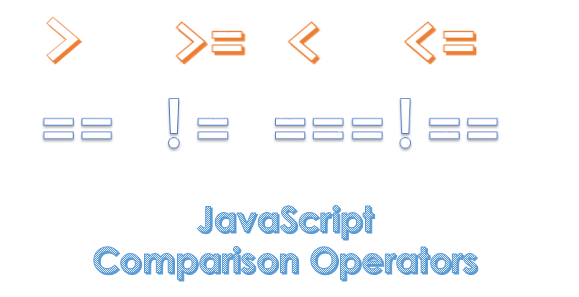Summary: in this tutorial, you will learn how to use JavaScript comparison operators to compare two values.
Introduction to JavaScript comparison operators
To compare two values, you use a comparison operator. The following table shows the comparison operators in JavaScript:
| Operator | Meaning |
|---|---|
| < | less than |
| > | greater than |
| <= | less than or equal to |
| >= | greater than or equal to |
| == | equal to |
| != | not equal to |
A comparison operator returns a Boolean value indicating whether the comparison is true or not. See the following example:
let r1 = 20 > 10; // true
let r2 = 20 < 10; // false
let r3 = 10 == 10; // trueCode language: JavaScript (javascript)
A comparison operator takes two values. If the types of values are not comparable, the comparison operator converts them into values of comparable types according to specific rules.
Compare numbers
If values are numbers, the comparison operators perform a numeric comparison. For example:
let a = 10,
b = 20;
console.log(a >= b); // false
console.log(a == 10); // trueCode language: JavaScript (javascript)This example is straightforward. The variable a is 10, b is 20. The expression a >= b expression returns false and the expression a == 10 expression returns true.
Compare strings
If the operands are strings, JavaScript compares the character codes numerically one by one in the string.
let name1 = 'alice',
name2 = 'bob';
let result = name1 < name2;
console.log(result); // true
console.log(name1 == 'alice'); // trueCode language: JavaScript (javascript)Because JavaScript compares the character codes in the strings numerically, you may receive an unexpected result, for example:
let f1 = 'apple',
f2 = 'Banana';
let result = f2 < f1;
console.log(result); // trueCode language: JavaScript (javascript)In this example, f2 is less than f1 because the letter B has the character code 66 while the letter a has the character code 97.
To fix this, you need to:
- First, convert the strings into a common format, either lowercase or uppercase
- Second, compare the converted values
For example:
let f1 = 'apple',
f2 = 'Banana';
let result = f2.toLowerCase() < f1.toLowerCase();
console.log(result); // falseCode language: JavaScript (javascript)Note that the toLowerCase() is a method of the String object that converts the string to lowercase.
Compare a number with a value of another type
If one value is a number and the other is not, the comparison operator will convert the non-numeric value into a number and compare them numerically. For example:
console.log(10 < '20'); // trueCode language: JavaScript (javascript)In this example, the comparison operator converts the string '20' into the number 20 and compares with the number 10. Here is an example:
console.log(10 == '10'); // trueCode language: JavaScript (javascript)In this example, the comparison operator converts the string '10' into the number 10 and compares them numerically.
Compare an object with a non-object
If a value is an object, the valueOf() method of that object is called to return the value for comparison. If the object doesn’t have the valueOf() method, the toString() method is called instead. For example:
let apple = {
valueOf: function () {
return 10;
},
};
let orange = {
toString: function () {
return '20';
},
};
console.log(apple > 10); // false
console.log(orange == 20); // true
Code language: JavaScript (javascript)In this first comparison, the apple object has the valueOf() method that returns 10. Therefore, the comparison operator uses the number 10 for comparison.
In the second comparison, JavaScript first calls the valueOf() method. However, the orange object doesn’t have the valueOf() method. So JavaScript calls the toString() method to get the returned value of 20 for comparison.
Compare a Boolean with another value
If a value is a Boolean value, JavaScript converts it to a number and compares the converted value with the other value; true is converted to 1 and false is converted to 0. For example:
console.log(true > 0); // true
console.log(false < 1); // true
console.log(true > false); // true
console.log(false > true); // false
console.log(true >= true); // true
console.log(true <= true); // true
console.log(false <= false); // true
console.log(false >= false); // trueCode language: JavaScript (javascript)In addition to the above rules, the equal (==) and not equal (!=) operators also have the following rules.
Compare null and undefined
In JavaScript, null equals undefined. It means that the following expression returns true.
console.log(null == undefined); // trueCode language: JavaScript (javascript)Compare NaN with other values
If either value is NaN, then the equal operator(==) returns false.
console.log(NaN == 1); // falseCode language: JavaScript (javascript)Even
console.log(NaN == NaN); // falseCode language: JavaScript (javascript)The not-equal (!=) operator returns true when comparing the NaN with another value:
console.log(NaN != 1); // trueCode language: JavaScript (javascript)And also
console.log(NaN != NaN); // trueCode language: JavaScript (javascript)Strict equal (===) and not strict equal (!==)
Besides the comparison operators above, JavaScript provides strict equal ( ===) and not strict equal ( !==) operators.
| Operator | Meaning |
|---|---|
| === | strict equal |
| !== | not strict equal |
The strict equal and not strict equal operators behave like the equal and not equal operators except that they don’t convert the operand before comparison. See the following example:
console.log("10" == 10); // true
console.log("10" === 10); // falseCode language: JavaScript (javascript)In the first comparison, since we use the equality operator, JavaScript converts the string into a number and performs the comparison.
However, in the second comparison, we use the strict equal operator ( ===), JavaScript doesn’t convert the string before comparison, therefore the result is false.
In this tutorial, you have learned how to use the JavaScript comparison operators to compare values.